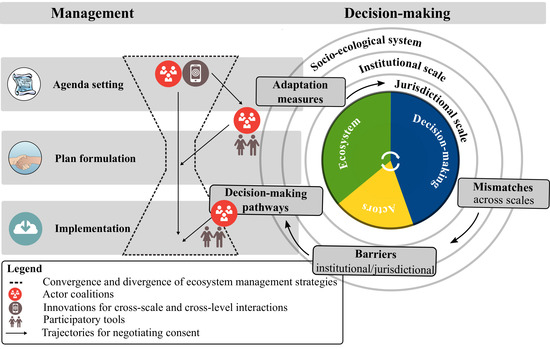Matching Ecosystem Functions with Adaptive Ecosystem Management: Decision Pathways to Overcome Institutional Barriers
Abstract
:1. Introduction
- What mismatches exist across jurisdictional and ecosystem scales, and which actors must be involved in the processes of identifying institutional constraints when adaptive ecosystem management needs to be implemented?
- What barriers exist between jurisdictional and institutional scales that prevent the implementation of adaptive management to support ecosystem function?
- What time frames for decision pathways are considered and how do actors collaborate to implement each flexible arrangement?
2. Methods
2.1. Clarification of Terms
- Ecosystem scale: biophysical phenomena that take place in different areas (region, landscape, patch [51]);
- Jurisdictional scale: administrations or actors that are involved in managing the ecosystem and where decisions are made (national, state, localities);
- Institutional scale/framework: policies, legislation and regulation for the conservation of the ecosystem and the division of jurisdictions;
- Temporal scale: decisions taken by administrations or actors that follow the political and policy cycle with outcomes of environmental management decisions (<5 years, short time scale) or outcomes that follow ecosystem processes (>10 years, long time scale) [52];
- Cross-level: interactions among levels within a scale, for example, between local and state actors with the jurisdiction scale;
- Mismatch: the problem of fit involving jurisdiction and institutions that do not map coherently onto to the bio-geophysical phenomena of the ecosystem, either in space or time [53];
- Governance: the ways and means employed by actors to make collective decisions, choose collective goals, and take action to achieve those goals;
- Decision pathway: cross level interaction within the jurisdictional domain to allow the implementation of adaptation measures that match the biophysical levels of the ecosystem. We make two distinctions on the temporal scale of decisions: those that only depend on cross-level jurisdictional cooperation on a local level are identified as ‘short-term’ decisions, whereas ‘long-term’ decisions require across-level collaboration of jurisdictions.
2.2. Case Study Description and the Actors Involved in Conservation
2.3. Research Design and Data Collection
- Which actor(s) is/are responsible for the execution of each adaptation measure at the jurisdictional scale;
- At which ecosystem level an adaptation measure has the largest impact at the ecosystem scale;
- Which policy or legislation needs amendment and at which level does such decision take place; and
- Which limitations/barriers arise when adaptive measures are implemented?
3. Results
3.1. Jurisdictional, Ecosystem, and Institutional Mismatches
3.2. Adaptive Management and Its Barriers across Scales
- The institutional framework includes the protection of individual rights of people, but also a common right to the conservation of ecosystems. This leads to conflicting interests when adaption measures are implemented;
- Local level actors are prevented from implementing adaptive management due to their jurisdiction that is determined by state-level institutions. This means that actions to improve ecosystem conservation by a local government are limited as result of state planning and water policies. For example, a local government cannot demand restrictions of groundwater use by individuals (arranged in state groundwater policy), despite this action supports adequate water levels in the wetland.
3.3. Actor Roles and Decision Pathways for Ecosystem Management
- Local level actors in a shared jurisdiction implement adaptation measures according to agreed objectives (example in Section 3.1);
- Local level actors that negotiate plan formulation with actors that operate at a single level to support the implementation on local level (example in Figure 6);
- Local level actors that negotiate plan formulation with actors that operate multiple levels to support the implementation on local level (example in Figure 7);
- Local level actors reach consensus for agenda setting on both individual rights and adaptation measures to improve ecosystem conservation and propose a plan for institutional amendments (explained in Figure 8);
4. Discussion
4.1. Temporal and Spatial Arrangements Applied to Ecosystem Conservation
4.2. From Adaptive Governance to Decision-Making for Adaptive Ecosystem Management
5. Conclusions
Supplementary Materials
Author Contributions
Acknowledgments
Conflicts of Interest
References
- Folke, C.; Hahn, T.; Olsson, P.; Norberg, J. Adaptive governance of social-ecological systems. Annu. Rev. Environ. Resour. 2005, 30, 441–473. [Google Scholar] [CrossRef]
- Holling, C.S. Resilience and stability of ecological systems. Annu. Rev. Ecol. Syst. 1973, 4, 1–23. [Google Scholar] [CrossRef]
- Scheffer, M.; Carpenter, S.; Foley, J.A.; Folke, C.; Walker, B. Catastrophic shifts in ecosystems. Nature 2001, 413, 591–596. [Google Scholar] [CrossRef] [PubMed]
- Folke, C.; Carpenter, S.; Walker, B.; Scheffer, M.; Elmqvist, T.; Gunderson, L.; Holling, C.S. Regime shifts, resilience, and biodiversity in ecosystem management. Annu. Rev. Ecol. Evol. Syst. 2004, 35, 557–581. [Google Scholar] [CrossRef]
- Carpenter, S.R.; Brock, W.A.; Folke, C.; van Nes, E.H.; Scheffer, M. Allowing variance may enlarge the safe operating space for exploited ecosystems. Proc. Natl. Acad. Sci. USA 2015, 112, 14384–14389. [Google Scholar] [CrossRef] [PubMed]
- Szaro, R.C.; Berc, J.; Cameron, S.; Cordle, S.; Crosby, M.; Martin, L.; Norton, D.; O’Malley, R.; Ruark, G. The ecosystem approach: Science and information management issues, gaps and needs. Landsc. Urban Plan. 1998, 40, 89–101. [Google Scholar] [CrossRef]
- Opdam, P.; Wascher, D. Climate change meets habitat fragmentation: Linking landscape and biogeographical scale levels in research and conservation. Biol. Conserv. 2004, 117, 285–297. [Google Scholar] [CrossRef]
- Zevenbergen, C.; Veerbeek, W.; Gersonius, B.; Van Herk, S. Challenges in urban flood management: Travelling across spatial and temporal scales. J. Flood Risk Manag. 2008, 1, 81–88. [Google Scholar]
- Sivapalan, M.; Blöschl, G. Time scale interactions and the coevolution of humans and water. Water Resour. Res. 2015, 51, 6988–7022. [Google Scholar] [CrossRef]
- Sousa Júnior, W.; Baldwin, C.; Camkin, J.; Fidelman, P.; Silva, O.; Neto, S.; Smith, T. Water: Drought, crisis and governance in Australia and Brazil. Water 2016, 8, 493. [Google Scholar] [CrossRef]
- Folke, C.; Carpenter, S.; Elmqvist, T.; Gunderson, L.; Holling, C.S.; Walker, B. Resilience and sustainable development: Building adaptive capacity in a world of transformations. AMBIO A J. Hum. Environ. 2002, 31, 437–440. [Google Scholar] [CrossRef]
- Cosens, B. Transboundary river governance in the face of uncertainty: Resilience theory and the columbia river treaty. J. Land Resour. Environ. Law 2010, 30, 229. [Google Scholar]
- Suchman, M.C. Managing legitimacy: Strategic and institutional approaches. Acad. Manag. Rev. 1995, 20, 571–610. [Google Scholar] [CrossRef]
- Cosens, B. Legitimacy, adaptation, and resilience in ecosystem management. Ecol. Soc. 2013, 18. [Google Scholar] [CrossRef]
- Borgström, S.; Elmqvist, T.; Angelstam, P.; Alfsen-Norodom, C. Scale mismatches in management of urban landscapes. Ecol. Soc. 2006, 11, 16. [Google Scholar] [CrossRef]
- Young, O.R. Effectiveness of international environmental regimes: Existing knowledge, cutting-edge themes, and research strategies. Proc. Natl. Acad. Sci. USA 2011, 108, 19853–19860. [Google Scholar] [CrossRef] [PubMed]
- Cash, D.; Adger, W.N.; Berkes, F.; Garden, P.; Lebel, L.; Olsson, P.; Pritchard, L.; Young, O. Scale and cross-scale dynamics: Governance and information in a multilevel world. Ecol. Soc. 2006, 11, 8. [Google Scholar] [CrossRef]
- Stafford Smith, M.; Horrocks, L.; Harvey, A.; Hamilton, C. Rethinking adaptation for a 4 °C world. Philos. Trans. A Math. Phys. Eng. Sci. 2011, 369, 196–216. [Google Scholar] [CrossRef] [PubMed]
- Schultz, L.; Folke, C.; Osterblom, H.; Olsson, P. Adaptive governance, ecosystem management, and natural capital. Proc. Natl. Acad. Sci. USA 2015, 112, 7369–7374. [Google Scholar] [CrossRef] [PubMed]
- Boyd, E.; Folke, C. Adapting Institutions: Governance, Complexity and Social-Ecological Resilience; Cambridge University Press: Cambridge, UK, 2011. [Google Scholar]
- Abel, N.; Cumming, D.H.; Anderies, J. Collapse and reorganization in social-ecological systems: Questions, some ideas, and policy implications. Ecol. Soc. 2006, 11, 17. [Google Scholar] [CrossRef]
- Medema, W.; Adamowski, J.; Orr, C.; Furber, A.; Wals, A.; Milot, N. Building a foundation for knowledge co-creation in collaborative water governance: Dimensions of stakeholder networks facilitated through bridging organizations. Water 2017, 9, 60. [Google Scholar] [CrossRef]
- Van Buuren, A.; Driessen, P.; Teisman, G.; van Rijswick, M. Toward legitimate governance strategies for climate adaptation in the netherlands: Combining insights from a legal, planning, and network perspective. Reg. Environ. Chang. 2014, 14, 1021–1033. [Google Scholar] [CrossRef]
- Van Buuren, A.; Ellen, G.J.; Warner, J.F. Path-dependency and policy learning in the dutch delta: Toward more resilient flood risk management in the netherlands? Ecol. Soc. 2016, 21, 43. [Google Scholar] [CrossRef]
- Pahl-Wostl, C. A conceptual framework for analysing adaptive capacity and multi-level learning processes in resource governance regimes. Glob. Environ. Chang. 2009, 19, 354–365. [Google Scholar] [CrossRef]
- Ferguson, B.C.; Brown, R.R.; Deletic, A. A diagnostic procedure for transformative change based on transitions, resilience, and institutional thinking. Ecol. Soc. 2013, 18, 57. [Google Scholar] [CrossRef]
- Huntjens, P.; Pahl-Wostl, C.; Rihoux, B.; Schlüter, M.; Flachner, Z.; Neto, S.; Koskova, R.; Dickens, C.; Nabide Kiti, I. Adaptive water management and policy learning in a changing climate: A formal comparative analysis of eight water management regimes in Europe, Africa and Asia. Environ. Policy Gov. 2011, 21, 145–163. [Google Scholar] [CrossRef]
- Rijke, J.; Brown, R.; Zevenbergen, C.; Ashley, R.; Farrelly, M.; Morison, P.; van Herk, S. Fit-for-purpose governance: A framework to make adaptive governance operational. Environ. Sci. Policy 2012, 22, 73–84. [Google Scholar] [CrossRef]
- Rijke, J.; Farrelly, M.; Brown, R.; Zevenbergen, C. Configuring transformative governance to enhance resilient urban water systems. Environ. Sci. Policy 2013, 25, 62–72. [Google Scholar] [CrossRef]
- Seijger, C.; Douven, W.; van Halsema, G.; Hermans, L.; Evers, J.; Phi, H.L.; Khan, M.F.; Brunner, J.; Pols, L.; Ligtvoet, W.; et al. An analytical framework for strategic delta planning: Negotiating consent for long-term sustainable delta development. J. Environ. Plan. Manag. 2017, 60, 1485–1509. [Google Scholar] [CrossRef]
- Cosens, B.A.; Williams, M.K. Resilience and water governance: Adaptive governance in the Columbia River basin. Ecol. Soc. 2012, 17, 3. [Google Scholar] [CrossRef]
- Adelle, C.; Russel, D. Climate policy integration: A case of déjà vu? Environ. Policy Gov. 2013, 23, 1–12. [Google Scholar] [CrossRef]
- Gersonius, B.; Ashley, R.; Zevenbergen, C. The identity approach for assessing socio-technical resilience to climate change: Example of flood risk management for the Island of Dordrecht. Nat. Hazards Earth Syst. Sci. 2012, 12, 2139–2146. [Google Scholar] [CrossRef] [Green Version]
- Bölscher, T.; van Slobbe, E.; van Vliet, M.T.; Werners, S.E. Adaptation turning points in river restoration? The rhine salmon case. Sustainability 2013, 5, 2288–2304. [Google Scholar] [CrossRef]
- Werners, S.; Swart, R.; van Slobbe, E.; Bölscher, T. Turning points in climate change adaptation. Glob. Environ. Chang. 2013, 16, 253–267. [Google Scholar]
- Werners, S.E.; van Loon-Steensma, J.M.; Oost, A.P. Method selection in adaptation research: The case of the delta programme for the Dutch Wadden region. Reg. Environ. Chang. 2015, 16, 111–122. [Google Scholar] [CrossRef]
- Van der Brugge, R.; Roosjen, R. An institutional and socio-cultural perspective on the adaptation pathways approach. J. Water Clim. Chang. 2015, 6, 743–758. [Google Scholar]
- Sabatier, P.A. Top-down and bottom-up approaches to implementation research: A critical analysis and suggested synthesis. J. Public Policy 1986, 6, 21–48. [Google Scholar] [CrossRef]
- Reed, M.S. Stakeholder participation for environmental management: A literature review. Biol. Conserv. 2008, 141, 2417–2431. [Google Scholar] [CrossRef]
- Stringer, L.; Dougill, A.; Fraser, E.; Hubacek, K.; Prell, C.; Reed, M. Unpacking “participation” in the adaptive management of social–ecological systems: A critical review. Ecol. Soc. 2006, 11, 39. [Google Scholar] [CrossRef]
- Williams, B.K.; Brown, E.D. Technical challenges in the application of adaptive management. Biol. Conserv. 2016, 195, 255–263. [Google Scholar] [CrossRef]
- Berman, R.; Quinn, C.; Paavola, J. The role of institutions in the transformation of coping capacity to sustainable adaptive capacity. Environ. Dev. 2012, 2, 86–100. [Google Scholar] [CrossRef]
- Hartig, J.H.; Zarull, M.A.; Law, N.L. An ecosystem approach to great lakes management: Practical steps. J. Great Lakes Res. 1998, 24, 739–750. [Google Scholar] [CrossRef]
- Sánchez, L.E.; Morrison-Saunders, A. Learning about knowledge management for improving environmental impact assessment in a government agency: The western australian experience. J. Environ. Manag. 2011, 92, 2260–2271. [Google Scholar] [CrossRef] [PubMed]
- Pace, M.L.; Carpenter, S.R.; Cole, J.J. With and without warning: Managing ecosystems in a changing world. Front. Ecol. Environ. 2015, 13, 460–467. [Google Scholar] [CrossRef]
- Green, O.O.; Garmestani, A.S.; van Rijswick, H.F.M.W.; Keessen, A.M. Eu water governance: Striking the right balance between regulatory flexibility and enforcement? Ecol. Soc. 2013, 18, 10. [Google Scholar] [CrossRef]
- Newig, J.; Pahl-Wostl, C.; Sigel, K. The role of public participation in managing uncertainty in the implementation of the water framework directive. Eur. Environ. 2005, 15, 333–343. [Google Scholar] [CrossRef]
- Dewulf, A.; Meijerink, S.; Runhaar, H. Editorial: The governance of adaptation to climate change as a multi-level, multi-sector and multi-actor challenge: A european comparative perspective. J. Water Clim. Chang. 2015, 6, 1–8. [Google Scholar] [CrossRef] [Green Version]
- Haasnoot, M.; Kwakkel, J.H.; Walker, W.E.; ter Maat, J. Dynamic adaptive policy pathways: A method for crafting robust decisions for a deeply uncertain world. Glob. Environ. Chang. 2013, 23, 485–498. [Google Scholar] [CrossRef]
- Bloemen, P.; Reeder, T.; Zevenbergen, C.; Rijke, J.; Kingsborough, A. Lessons learned from applying adaptation pathways in flood risk management and challenges for the further development of this approach. Mitig. Adapt. Strateg. Glob. Chang. 2017, 1–26. [Google Scholar] [CrossRef]
- Poiani, K.A.; Richter, B.D.; Anderson, M.G.; Richter, H.E. Biodiversity conservation at multiple scales: Functional sites, landscapes, and networks. BioScience 2000, 50, 133–146. [Google Scholar] [CrossRef]
- MacMynowski, D.P. Across space and time: Social responses to large-scale biophysical systems. Environ. Manag. 2007, 39, 831–842. [Google Scholar] [CrossRef] [PubMed]
- Gibson, C.C.; Ostrom, E.; Ahn, T.K. The concept of scale and the human dimensions of global change: A survey. Ecol. Econ. 2000, 32, 217–239. [Google Scholar] [CrossRef]
- Dawes, W.; Barron, O.; Donn, M.; Pollock, D.; Johnstone, C. Forrestdale Lake Water Balance; CSIRO Water for a Healthy Country National Research Flagship: Perth, Australia, 2009. [Google Scholar]
- Nanda, A.V.V.; Beesley, L.; Locatelli, L.; Gersonius, B.; Hipsey, M.R.; Ghadouani, A. Adaptation tipping points of a wetland under a drying climate. Water 2018, 10, 234. [Google Scholar] [CrossRef]
- Van Buuren, A.; Keessen, A.M.; van Leeuwen, C.; Eshuis, J.; Ellen, G.J. Implementation arrangements for climate adaptation in the netherlands: Characteristics and underlying mechanisms of adaptive governance. Ecol. Soc. 2015, 20, 11. [Google Scholar] [CrossRef]
- Maltby, E.; Acreman, M.; Blackwell, M.S.A.; Everard, M.; Morris, J. The challenges and implications of linking wetland science to policy in agricultural landscapes—Experience from the UK national ecosystem assessment. Ecol. Eng. 2013, 56, 121–133. [Google Scholar] [CrossRef]
- Goddard, M.A.; Dougill, A.J.; Benton, T.G. Scaling up from gardens: Biodiversity conservation in urban environments. Trends Ecol. Evol. 2010, 25, 90–98. [Google Scholar] [CrossRef] [PubMed]
- Radhakrishnan, M.; Pathirana, A.; Ashley, R.; Zevenbergen, C. Structuring climate adaptation through multiple perspectives: Framework and case study on flood risk management. Water 2017, 9, 129. [Google Scholar] [CrossRef]
- Eshuis, J.; van Buuren, A. Innovations in water governance: The importance of time. Int. Rev. Adm. Sci. 2014, 80, 401–420. [Google Scholar] [CrossRef]
- Howes, M.; Tangney, P.; Reis, K.; Grant-Smith, D.; Heazle, M.; Bosomworth, K.; Burton, P. Towards networked governance: Improving interagency communication and collaboration for disaster risk management and climate change adaptation in Australia. J. Environ. Plan. Manag. 2014, 58, 757–776. [Google Scholar] [CrossRef]
- Opdam, P.; Pouwels, R.; Rooij, S.V. Setting biodiversity targets in participatory regional planning: Introducing ecoprofiles. Ecol. Sci. 2008, 13, 20. [Google Scholar] [CrossRef]
- Glasbergen, P.; Klijn, F. Integrated water and wetland management: Towards a project approach. Landsc. Urban Plan. 1991, 20, 257–262. [Google Scholar] [CrossRef]
- Poiani, K.A.; Baumgartner, J.V.; Buttrick, S.C.; Green, S.L.; Hopkins, E.; Ivey, G.D.; Seaton, K.P.; Sutter, R.D. A scale-independent, site conservation planning framework in the nature conservancy. Landsc. Urban Plan. 1998, 43, 143–156. [Google Scholar] [CrossRef]
- Turner, M.G. Landscape ecology: What is the state of the science? Annu. Rev. Ecol. Evol. Syst. 2005, 36, 319–344. [Google Scholar] [CrossRef]
- Weston, M.A.; Antos, M.J.; Glover, H.K. Birds, buffers and bicycles: A review and case study of wetland buffers. Vic. Nat. 2009, 126, 79–86. [Google Scholar]
- Burke, V.J.; Gibbons, J.W. Terrestrial buffer zones and wetland conservation: A case study of freshwater turtles in a Carolina bay. Conserv. Biol. 1995, 9, 1365–1369. [Google Scholar] [CrossRef]
- Kiparsky, M.; Milman, A.; Owen, D.; Fisher, A. The importance of institutional design for distributed local-level governance of groundwater: The case of California’s sustainable groundwater management act. Water 2017, 9, 755. [Google Scholar] [CrossRef]
- Hughes, T.P.; Barnes, M.L.; Bellwood, D.R.; Cinner, J.E.; Cumming, G.S.; Jackson, J.B.C.; Kleypas, J.; van de Leemput, I.A.; Lough, J.M.; Morrison, T.H.; et al. Coral reefs in the Anthropocene. Nature 2017, 546, 82–90. [Google Scholar] [CrossRef] [PubMed]
- Moloney, S.; Fünfgeld, H. Emergent processes of adaptive capacity building: Local government climate change alliances and networks in Melbourne. Urban Clim. 2015, 14, 30–40. [Google Scholar] [CrossRef]
- Fünfgeld, H. Facilitating local climate change adaptation through transnational municipal networks. Curr. Opin. Environ. Sustain. 2015, 12, 67–73. [Google Scholar] [CrossRef]
- Hanna, S. Institutions for managing resilient salmon (Oncorhynchus spp.) ecosystems: The role of incentives and transaction costs. Ecol. Soc. 2008, 13, 35. [Google Scholar] [CrossRef]
- Huitema, D.; Mostert, E.; Egas, W.; Moellenkamp, S.; Pahl-Wostl, C.; Yalcin, R. Adaptive water governance: Assessing the institutional prescriptions of adaptive (co-) management from a governance perspective and defining a research agenda. Ecol. Soc. 2009, 14, 26. [Google Scholar] [CrossRef]
- Berkhout, F.; Hertin, J.; Gann, D.M. Learning to adapt: Organisational adaptation to climate change impacts. Clim. Chang. 2006, 78, 135–156. [Google Scholar] [CrossRef] [Green Version]
- Moser, S.C.; Ekstrom, J.A. A framework to diagnose barriers to climate change adaptation. Proc. Natl. Acad. Sci. USA 2010, 107, 22026–22031. [Google Scholar] [CrossRef] [PubMed]
- Van Herk, S.; Zevenbergen, C.; Ashley, R.; Rijke, J. Learning and action alliances for the integration of flood risk management into urban planning: A new framework from empirical evidence from the netherlands. Environ. Sci. Policy 2011, 14, 543–554. [Google Scholar] [CrossRef]
- Chaffin, B.C.; Garmestani, A.S.; Gunderson, L.H.; Benson, M.H.; Angeler, D.G.; Arnold, C.A.; Cosens, B.; Craig, R.K.; Ruhl, J.B.; Allen, C.R. Transformative environmental governance. Annu. Rev. Environ. Resour. 2016, 41, 399–423. [Google Scholar] [CrossRef]
- Van de Ven, F.H.M.; Snep, R.P.H.; Koole, S.; Brolsma, R.; van der Brugge, R.; Spijker, J.; Vergroesen, T. Adaptation planning support toolbox: Measurable performance information based tools for co-creation of resilient, ecosystem-based urban plans with urban designers, decision-makers and stakeholders. Environ. Sci. Policy 2016, 66, 427–436. [Google Scholar] [CrossRef]
- Cohen-Shacham, E.; Dayan, T.; Feitelson, E.; de Groot, R.S. Ecosystem service trade-offs in wetland management: Drainage and rehabilitation of the Hula, Israel. Hydrol. Sci. J. 2011, 56, 1582–1601. [Google Scholar] [CrossRef]
- Myers, S.C.; Clarkson, B.R.; Reeves, P.N.; Clarkson, B.D. Wetland management in New Zealand: Are current approaches and policies sustaining wetland ecosystems in agricultural landscapes? Ecol. Eng. 2013, 56, 107–120. [Google Scholar] [CrossRef]
- Newig, J.; Fritsch, O. Environmental governance: Participatory, multi-level–and effective? Environ. Policy Gov. 2009, 19, 197–214. [Google Scholar] [CrossRef]
- Lenton, T.M. Environmental tipping points. Annu. Rev. Environ. Resour. 2013, 38, 1–29. [Google Scholar] [CrossRef]
- Ekstrom, J.; Young, O. Evaluating functional fit between a set of institutions and an ecosystem. Ecol. Soc. 2009, 14, 16. [Google Scholar] [CrossRef]
- Olsson, P.; Gunderson, L.; Carpenter, S.; Ryan, P.; Lebel, L.; Folke, C.; Holling, C.S. Shooting the rapids: Navigating transitions to adaptive governance of social-ecological systems. Ecol. Soc. 2006, 11, 18. [Google Scholar] [CrossRef]
- Crook, D.A.; Lowe, W.H.; Allendorf, F.W.; Eros, T.; Finn, D.S.; Gillanders, B.M.; Hadwen, W.L.; Harrod, C.; Hermoso, V.; Jennings, S.; et al. Human effects on ecological connectivity in aquatic ecosystems: Integrating scientific approaches to support management and mitigation. Sci. Total Environ. 2015, 534, 52–64. [Google Scholar] [CrossRef] [PubMed] [Green Version]
- Nelson, D.R.; Adger, W.N.; Brown, K. Adaptation to environmental change: Contributions of a resilience framework. Annu. Rev. Environ. Resour. 2007, 32, 395–419. [Google Scholar] [CrossRef]
- Lebel, L.; Anderies, J.; Campbell, B.; Folke, C.; Hatfield-Dodds, S.; Hughes, T.; Wilson, J. Governance and the capacity to manage resilience in regional social-ecological systems. Ecol. Soc. 2006, 11, 19. [Google Scholar] [CrossRef]
- Hermans, L.M.; Haasnoot, M.; ter Maat, J.; Kwakkel, J.H. Designing monitoring arrangements for collaborative learning about adaptation pathways. Environ. Sci. Policy 2017, 69, 29–38. [Google Scholar] [CrossRef]
- Lawrence, J.; Haasnoot, M. What it took to catalyse uptake of dynamic adaptive pathways planning to address climate change uncertainty. Environ. Sci. Policy 2017, 68, 47–57. [Google Scholar] [CrossRef]
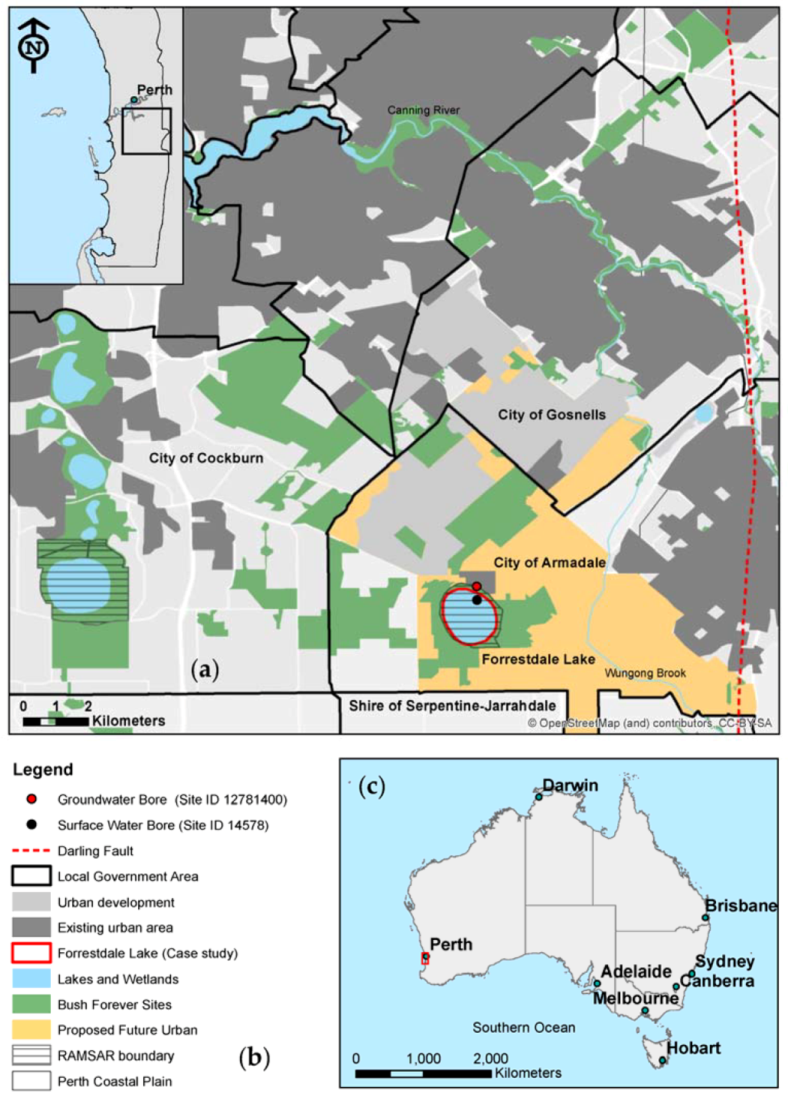
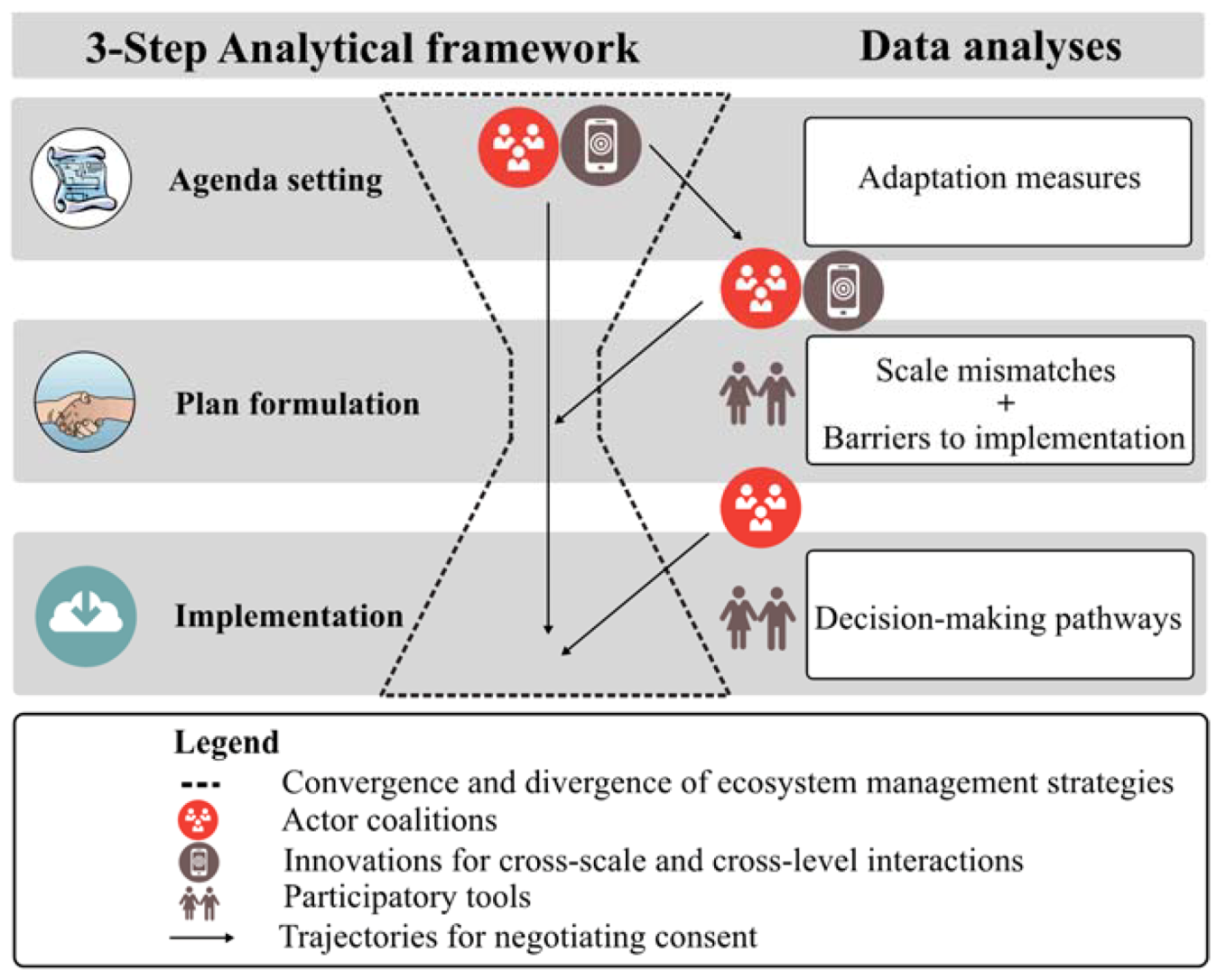

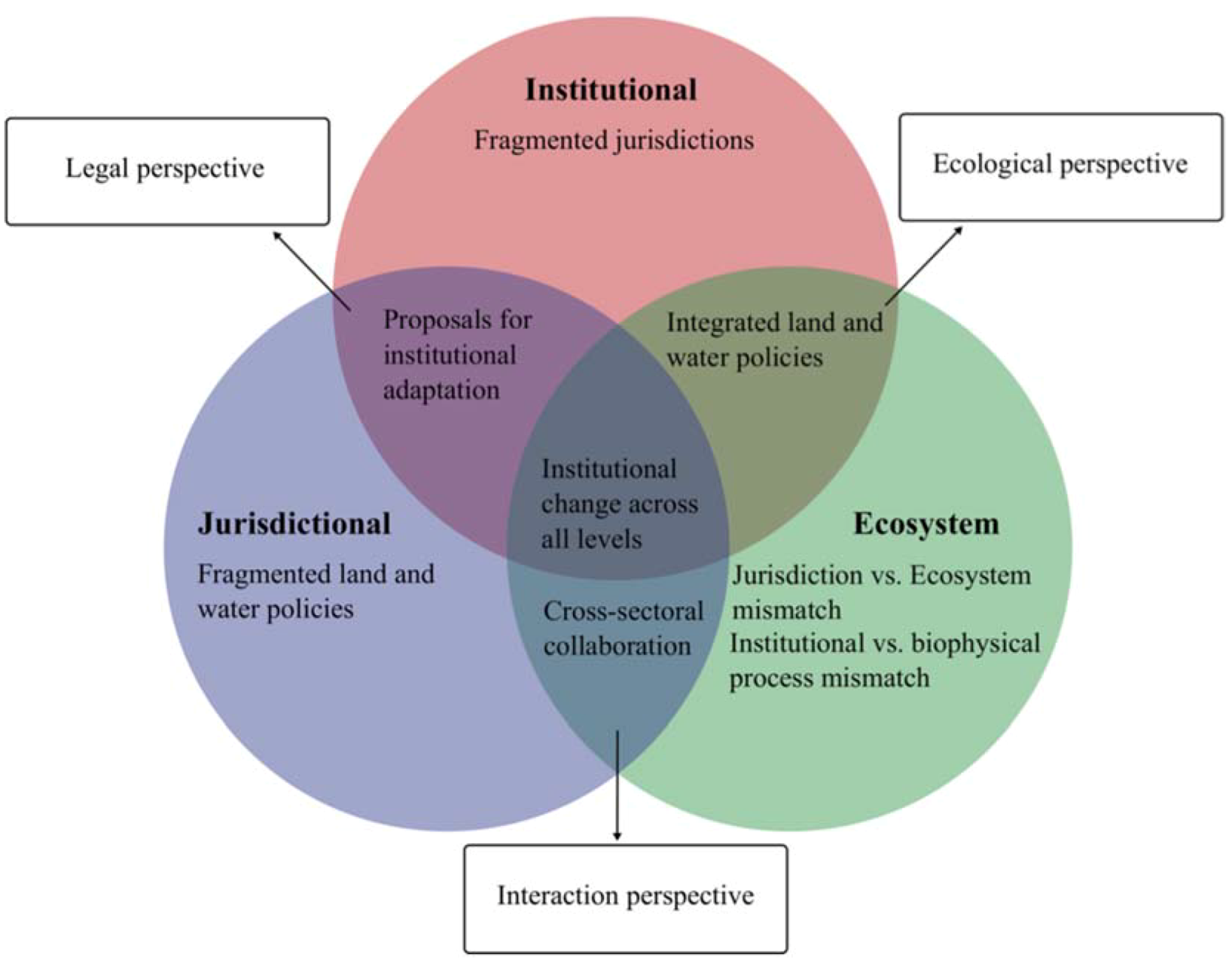
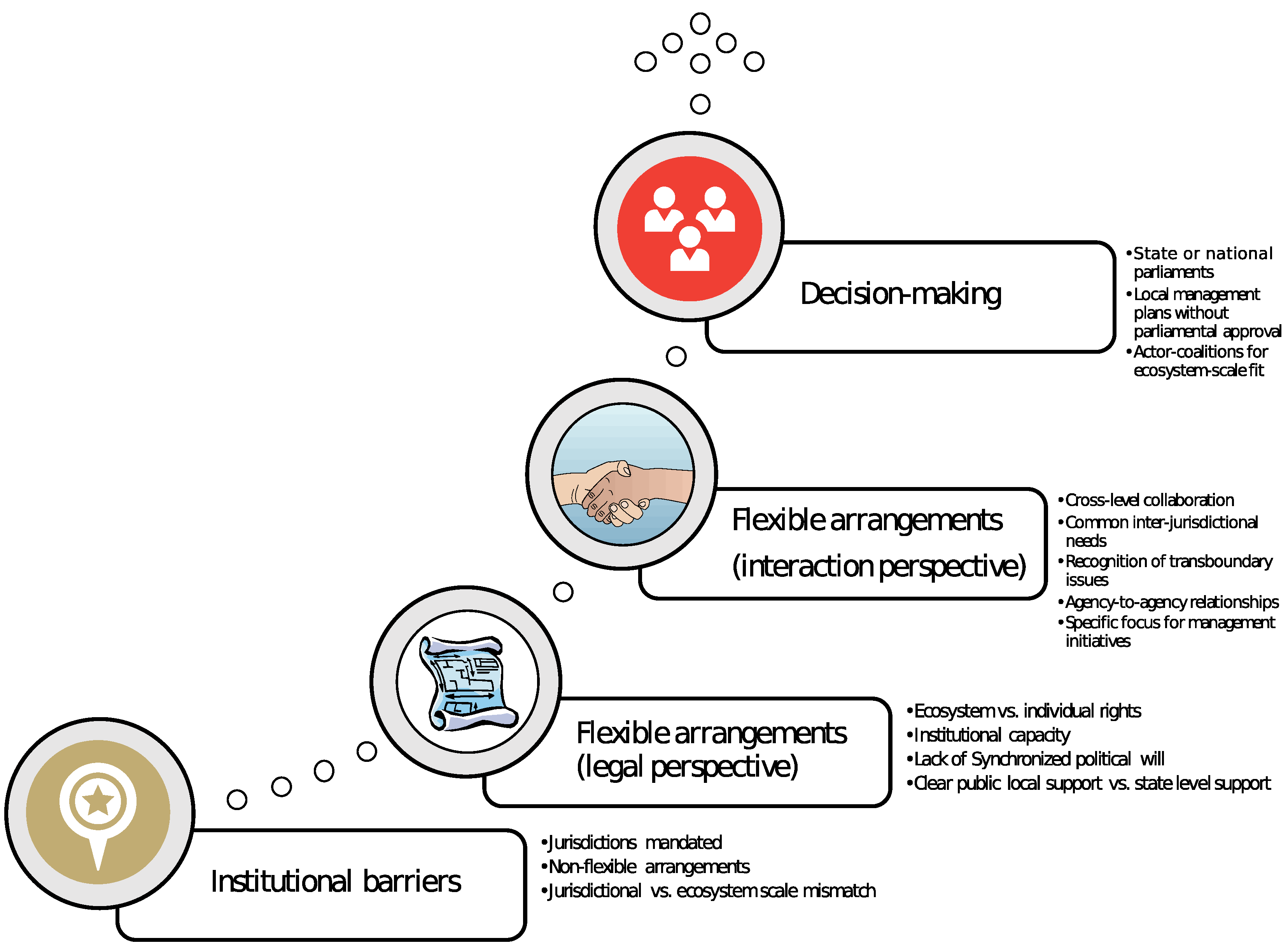
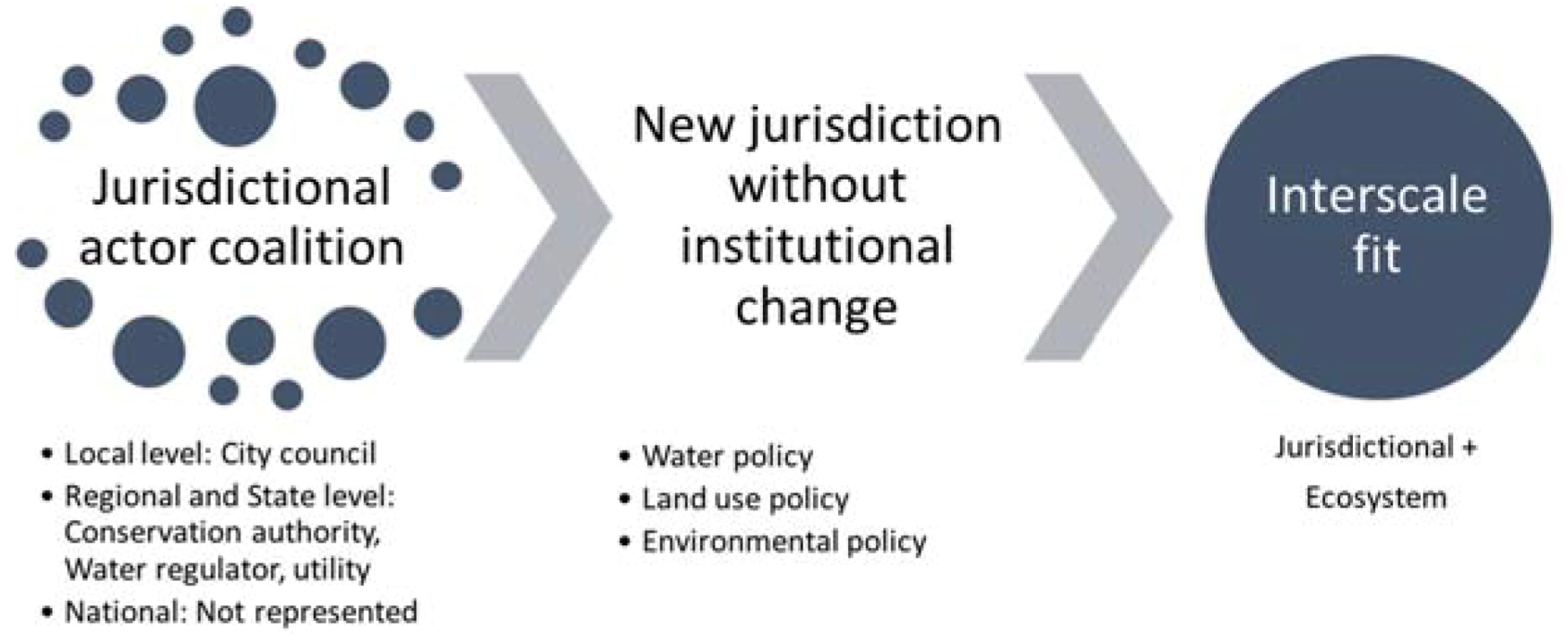
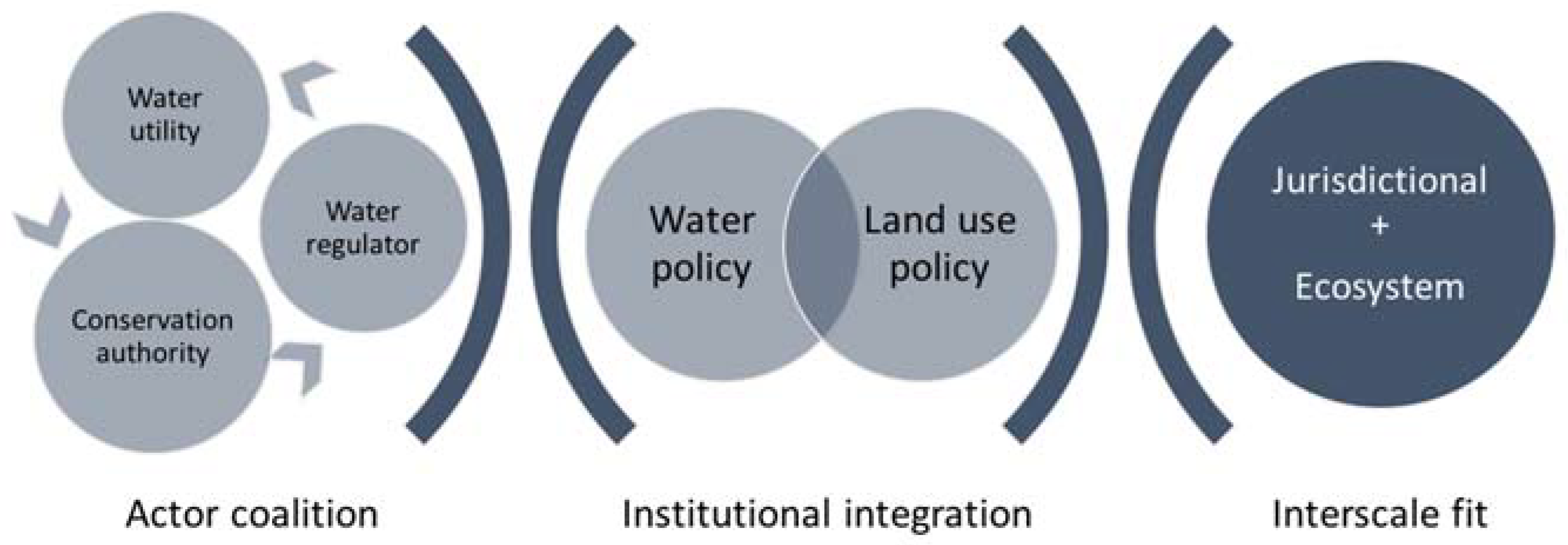

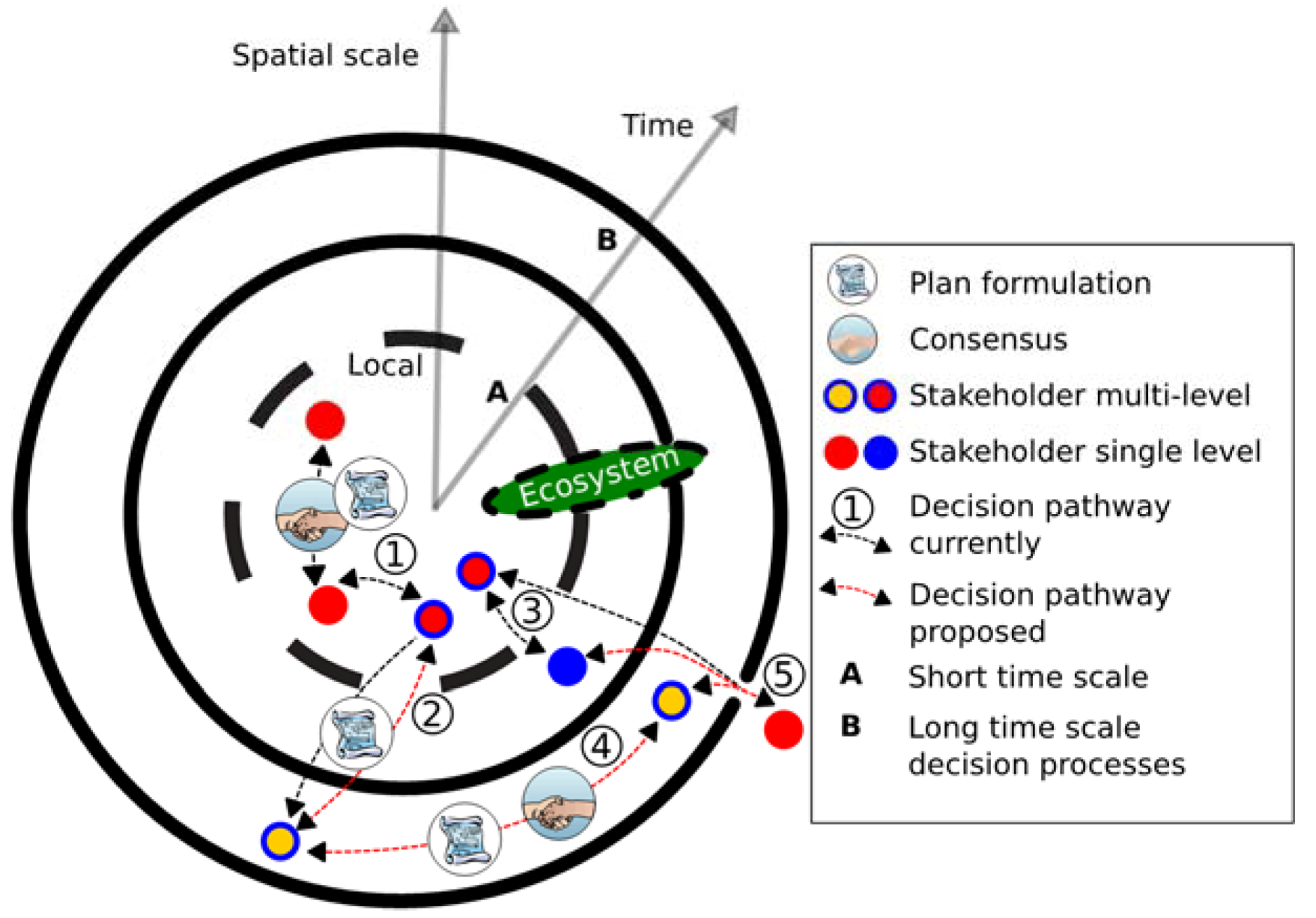
| Actor. | Administration | Task | Jurisdiction |
|---|---|---|---|
| Armadale local government | City council | Land division, drainage, and irrigation | Local |
| Department of Parks and Wildlife | Conservation authority | Conservation of biodiversity, wetland buffer zone, fire management, and public access | Local and Sate |
| Department of Water | Water regulator | Ground- and surface water allocation and monitoring | Local and State |
| Water Corporation | Water utility | Groundwater abstraction for drinking water, maintains large drains | Local and State |
| Urbaqua | Research institute | Groundwater modelling research in local catchment area | Local |
| Friends of Forrestdale | Community and local conservation group | Monitoring birds, revegetation and rehabilitation of the wetland buffer zone | Local |
| Commonwealth Government | Federal environmental department | Responsible for species protection according to Environmental Protection and Biodiversity Act | National |
| Interaction Perspective (i.e., among Actors) | |
| Characteristics | Barriers |
| Flexibility of content | Conflicting time frames and interests |
| Flexibility of the process | Obscure distribution of responsibilities between actors |
| Flexibility of the structure | Unclear distribution of costs and future benefits |
| Lack of trust between participants | |
| Legal perspective (i.e., legislation, policy) | |
| Characteristics | Barriers |
| Flexibility of content | The perceived need for legal certainty |
| Flexibility to adjust arrangements | The need to protect individual rights, |
| procedural guarantees and rights |
© 2018 by the authors. Licensee MDPI, Basel, Switzerland. This article is an open access article distributed under the terms and conditions of the Creative Commons Attribution (CC BY) license (http://creativecommons.org/licenses/by/4.0/).
Share and Cite
Nanda, A.V.V.; Rijke, J.; Beesley, L.; Gersonius, B.; Hipsey, M.R.; Ghadouani, A. Matching Ecosystem Functions with Adaptive Ecosystem Management: Decision Pathways to Overcome Institutional Barriers. Water 2018, 10, 672. https://doi.org/10.3390/w10060672
Nanda AVV, Rijke J, Beesley L, Gersonius B, Hipsey MR, Ghadouani A. Matching Ecosystem Functions with Adaptive Ecosystem Management: Decision Pathways to Overcome Institutional Barriers. Water. 2018; 10(6):672. https://doi.org/10.3390/w10060672
Chicago/Turabian StyleNanda, Amar V. V., Jeroen Rijke, Leah Beesley, Berry Gersonius, Matthew R. Hipsey, and Anas Ghadouani. 2018. "Matching Ecosystem Functions with Adaptive Ecosystem Management: Decision Pathways to Overcome Institutional Barriers" Water 10, no. 6: 672. https://doi.org/10.3390/w10060672
APA StyleNanda, A. V. V., Rijke, J., Beesley, L., Gersonius, B., Hipsey, M. R., & Ghadouani, A. (2018). Matching Ecosystem Functions with Adaptive Ecosystem Management: Decision Pathways to Overcome Institutional Barriers. Water, 10(6), 672. https://doi.org/10.3390/w10060672





